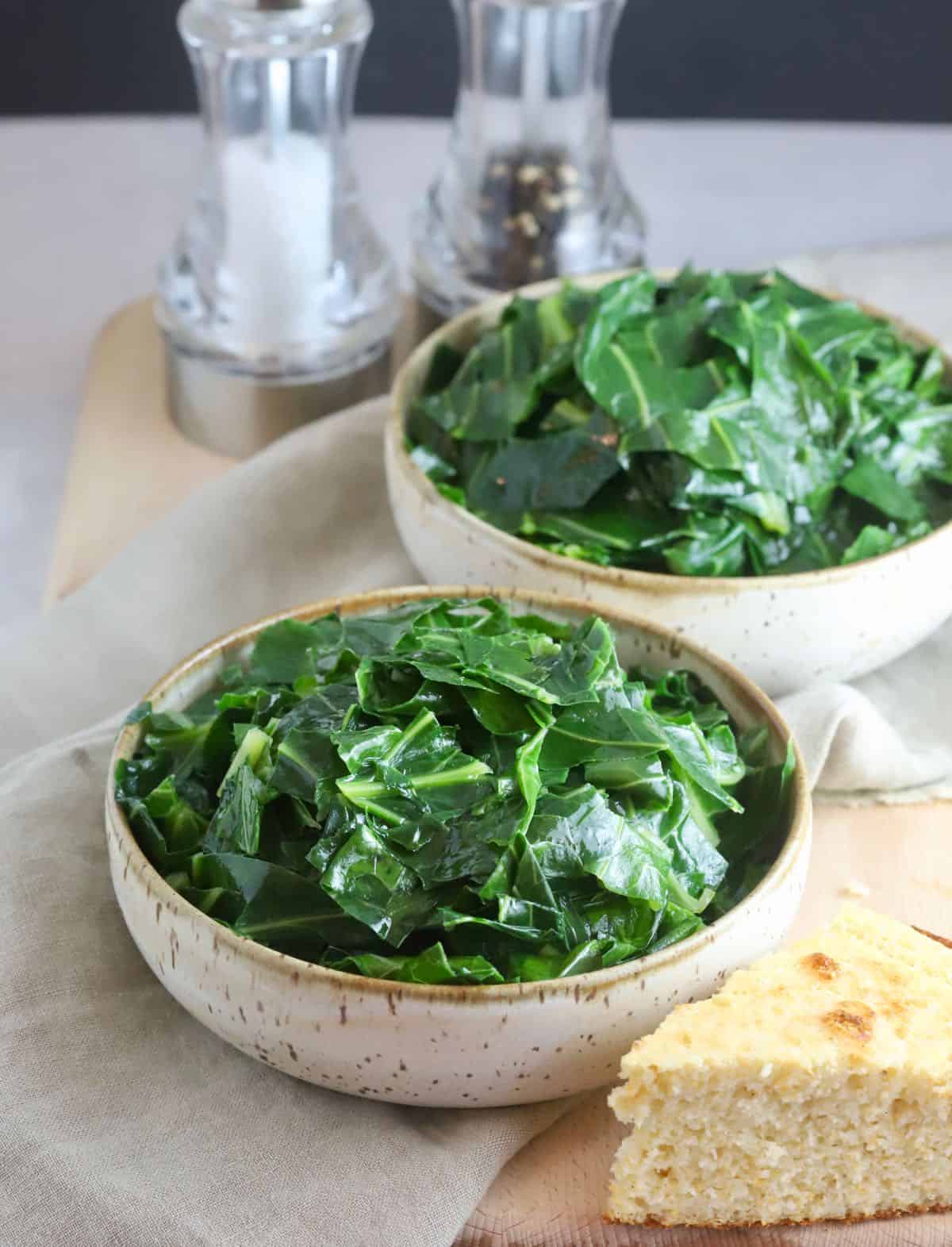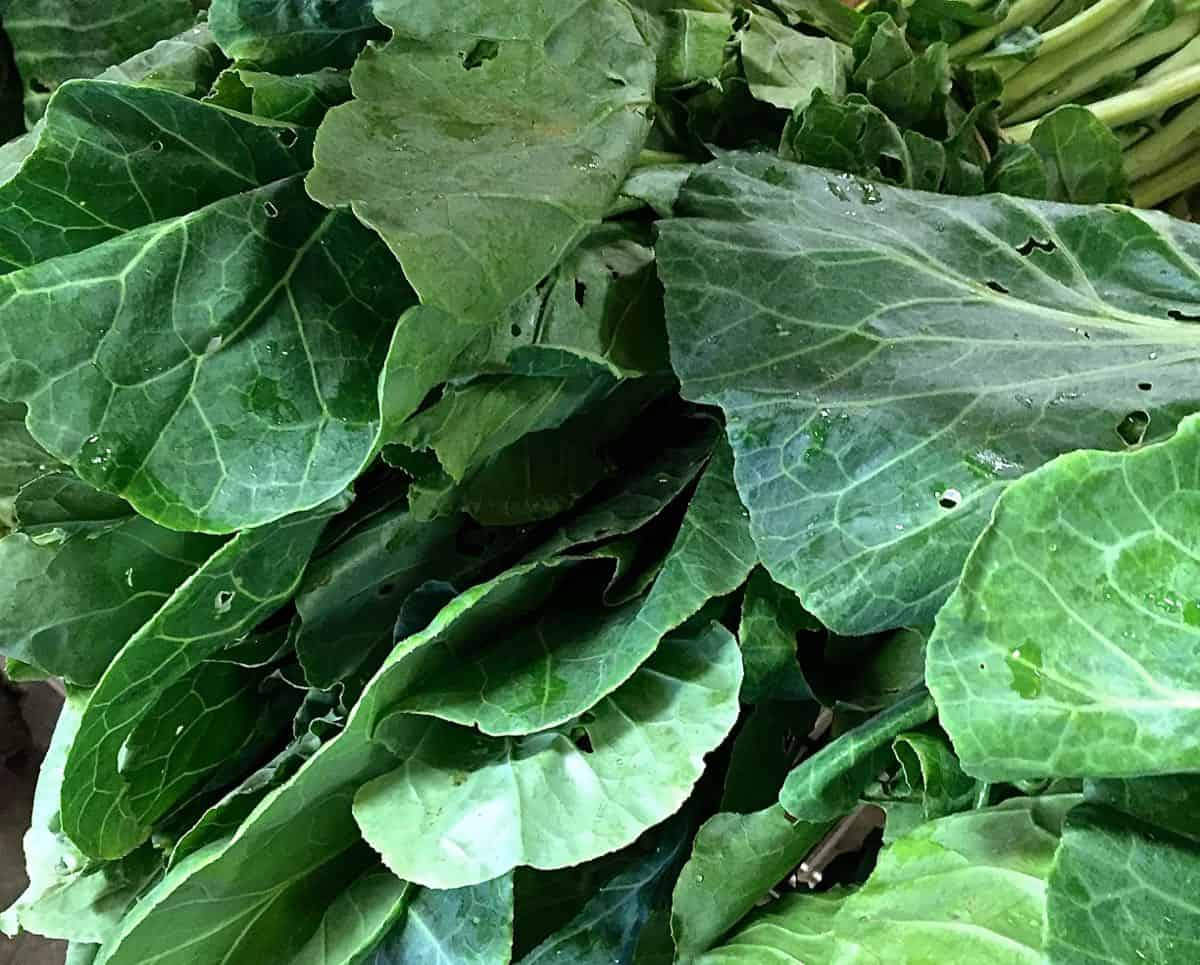There is more than one way to cook fresh collard greens, and this easy, vegan, healthy, Southern Collard Greens recipe is as simple as it is delicious! The best part, a single serving of this flavorful and nutritious side dish is less than 70 calories.

To some folks, the term “healthy southern recipe” is an oxymoron. But, in this healthy, vegetarian recipe, fresh collard greens are prepared without traditional ham hocks or other pork products. This helps their mild flavor and crisp-tender texture shine.
What are they?
Collard greens, a type of large green leafy vegetable, which has long been a staple in the South and considered “soul food,” has recently become trendy. New recipes and creative ways to serve them are popping up all over the internet, making use of the nutritious leaves in wraps, coleslaws, salads, and more.
In the South, we love our greens, and it’s traditional to eat black-eyed peas and collard greens for good luck and prosperity on New Year’s Day.
Collards grow best in cooler temperatures, and the peak season is January through April. However, these days you can find fresh collard greens in most grocery stores and farmers’ markets year-round.
Are they healthy?
Collard greens, which are considered a cruciferous vegetable like broccoli and cauliflower, are chock-full of vitamins K, B6, C, and E and are an excellent source of calcium, folate, and beta-carotene. According to Prevention, they also have high antioxidant levels, can help reduce inflammation, are low in calories, and high in soluble fiber.
Collard greens also have more calcium per serving than kale and double the amount of protein and iron.
Here’s what’s in this recipe:
There are only three ingredients: fresh collard greens, kosher salt, and olive oil.
How to clean them:
Although this recipe is as easy as they come, the leaves need to be washed thoroughly before cooking. This is in order to remove any sand or dirt.
To wash them, fill up a sink with water and submerge the leaves and swish them around. Depending on how sandy they are, you might have to repeat this process with clean water several times until there is no more sand in your sink.
After washing the leaves, let them dry, wrap them in a paper towel, and they can be stored in the refrigerator in a sealed plastic bag for up to five days.
How to remove the stems and prepare them for cooking:
Use a sharp knife to cut out each leaf’s tough center stalk and then stack the leaves on top of each other and slice into one-inch ribbons.
How to cook them:
- Fill a dutch oven or large pot about ⅓ of the way up with water. Place over high heat and bring to a boil. Add the olive oil and salt.
- Add the collards to the water and bring back to a boil. (You may need to add the collards in batches if they don’t all fit at one time. They will wilt down, and then you can add the rest.)
- When all of the greens have been added, and the water is boiling, turn the heat down to low and cover. Simmer for about 20 minutes. Taste and add more salt, if necessary.
- Continue to cook for about 10 more minutes.
- Serve immediately and include some of the flavorful “pot likker” (or pot liquor). This is the liquid the greens have cooked in.
What to serve with them:
Southern collard greens are almost always served with either Cornbread or Hoecakes. You will also often find Candied Sweet Potatoes, Field Peas, Purple Hull Peas, Zipper peas, or Black-Eyed Peas, as well as Southern Potato Salad as accompaniments.
They also pair well with Southern Fried Chicken, Brown Sugar Bourbon Glazed Ham, Easy Baked Pork Chops, or Chili Rubbed Pork Tenderloin with Apricot Glaze.
Sharon’s tips:
After cooking, your greens should not taste bitter; add a touch more salt if they do. It will help mellow out the flavor.
Leftovers can be stored covered in the refrigerator for up to five days. Leftovers can also be frozen and stored in an airtight container in the freezer for several months. To reheat them, if they are frozen, let them thaw, then place them in a saucepan over medium heat until they are hot.
If you have an abundance of collard greens, they can be frozen and stored in the freezer for up to twelve months. But, they must be blanched. First, follow the directions for cleaning and cutting them. Then, to blanch, add them to a large pot of boiling water and cook for three minutes. Immediately take them out and place them in an ice-water bath for three minutes to stop the cooking process. Then drain well and pack in air-tight freezer containers.
Related recipes:
If you like this dish, you might also like these other Southern recipes: Tomato Cobbler with Cornmeal-Cheddar Biscuits, The Ultimate Southern-Style Burger, Southern-Style Baked Mac and Cheese, Southern Sweet Potato Pie, Fried Green Tomatoes, and Southern-Style Crispy Onion Rings.
If you need more menu ideas or inspiration, check out all of my Southern recipes here.
**Special thanks to my friend Mary Carroll, who graciously shared her simple recipe for cooking these healthy collard greens.
★ If you make this dish, please leave a comment and give this recipe a star rating. I would love to know how you liked it!
Thank you so much for visiting Grits and Pinecones!
📋 Recipe:
Want to Save This Recipe?
Enter your email & I'll send it to your inbox. Plus, get great new recipes from me every week!
By submitting this form, you consent to receive emails from Grits and Pinecones.

Healthy Southern Collard Greens Recipe
Ingredients
- 2 bunches fresh collard greens thoroughly washed, about one pound of leaves
- ¼ cup olive oil
- 3 tablespoons kosher salt
Instructions
- Use a sharp knife to cut out the tough center stalk of each leaf and then stack the leaves on top of each other and slice into 1-inch ribbons.
- Fill up a dutch oven or large pot about one-third of the way with water. Place over high heat and bring to a boil. Add the olive oil and salt.
- Add the collards to the water and bring back to a boil. (You may need to add them in batches if they don't all fit at one time. They will wilt down, and then you can add the rest.) When all of the collards have been added and the water is boiling, turn the heat down to low, cover, and simmer for about 20 minutes. Taste and add more salt if necessary.
- Continue to cook for about 10 more minutes. Serve immediately, and be sure to include some of the flavorful "pot likker."













Tessa
What? no bacon? or onion? oh my
love your recipes anyway
Sharon Rigsby
Hi Tessa, I know it’s hard to believe…
All the best,
Sharon